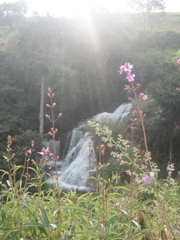Bamenda and Ndawara Tea Plantation Trip





Over Thanksgiving break, some friends and I took a trip to Bamenda in the Northwest province. We left Yaoundé on Thursday for an eight hour drive to the Ndawara Tea Estates. The tea plantation had tea as far as the eye could see!!! There were hills and hills of tea. If we would walk to the top of one hill, we would look out and see more hills of tea. It was one of the most beautiful views.
When we first arrived, we took a quick walk around the tea plantation. The sun was close to setting and we spotted people heading home from a hard day of work. Once we arrived at the our ranch house, I went out to the open field to play soccer with some of the children. They must have thought I was a funny sight to see because they all laughed when I went out there and ran amongst them. But, after a while, I got the hang of it and had a great time with them. I met a special friend named Adamou. He was a cute little boy who lived with his family on one of the mountains. We had small conversations with one another. He spoke a little of English and I spoke a bit of French. But, I think we enjoyed walking around with one another.
Our first evening there, we celebrated Thanksgiving dinner with a nice meal of beef, rice, and potatoes. We slept in a simple ranch house that included five rooms, a shared living room, a dining room, and a kitchen.
The next day, we received a tour of the entire tea plantation. First, we started out at the tea factory, which they are currently building. At this point, the tea that is picked at the plantation is sent down to the southwest for manual production. However, once the factory is built, they will produce tea at the plantation itself. Second, we went to an empty water tank, which I think will eventually hold water from the nearby crater lake. Afterwards, we went to see the crater lake and the tea nursery.
My favorite part of the trip was our horse tour to the plantation’s waterfalls. We rode the horses past wonderful plants including orchids and palm trees. And, we saw wild horses, and amazing views of the plantation. When we arrived at the waterfall, we had to tie up our horses and walk across an small iron bridge. Once we arrived at the other side, we were all amazed at the breathtaking waterfalls. Everyone in the group took out their cameras and began snapping photos. The guides told us that it is possible to go to the base of the waterfall, but we would have had to trek around to the other side of the mountain. When returning, our horses went wild because they knew they were heading home. They picked up the pace to a fast trot and we were home in no time.
The following day we spent the night in Bamenda town. We went to the town market to make some purchases. My big purchase for the trip was a nice wooden stool that I will take back with me to the states.
On the way back we stopped at the crated lake called Mount Mbapet. In the photos, we have the chateau (castle) where the owner of the tea plantation lives. Right across from the chateau is the mosque. The citizens of the Ndawara tea plantations are mostly Muslim.
Enjoy the photos!! Cameroon is beautiful.














































